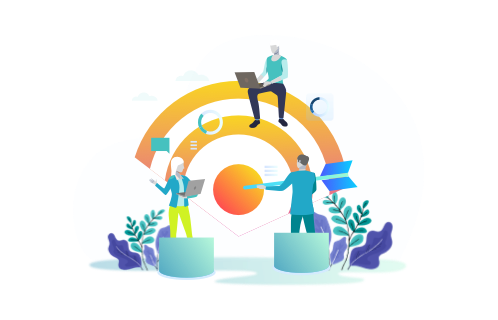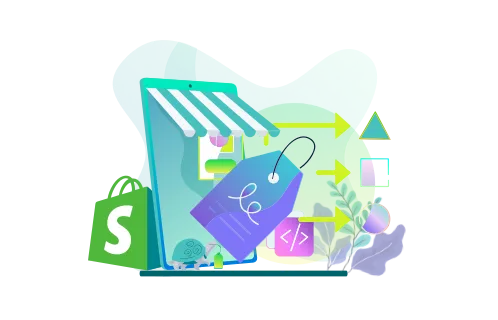Choosing the right eCommerce platform can make or break your business. Choosing an eCommerce solution that meets your current and future needs is essential. We know it can be hard to know what to look for. Regarding Shopify, your eCommerce store options include the basic package (which is Shopify) and an advanced plan (which is Shopify Plus).
There is no right choice between these two.
Both provide eCommerce solutions but do them differently and apply to different business situations.
Based on real-life examples with our clients, we at GenovaWebArt have determined 8 main differences between Shopify vs Shopify Plus to help you pick the right options and get the best experience with the Shopify platform.
Shopify Plus vs. Shopify: The Differences
Basically, Shopify and Shopify Plus work similarly, meaning the dashboard presence, editor tool, and the same help center. But when it comes to functionality, they are not the same — and clarifying the exact distinction between these two platforms is our task here.
Read more: Shopify Theme Development Services
To understand what is the difference between Shopify and Shopify Plus, it’s enough to know that Shopify Plus is ideal for larger websites and/or existing stores that want the ability to scale. It offers more flexibility than Shopify and comes with a higher monthly fee. Shopify Plus suits large stores or high-volume online merchants that need to customize their stores with advanced features.
For small eCommerce websites and startups, Shopify works better because it is affordable and easy to use.
Indeed, Shopify Plus provides more benefits in terms of speed, data integrity, performance, and support — but if you are starting a business, you may be interested in something a little less expensive to get up and run quickly without investing too much upfront.
| Differentiation criterion | ||
|---|---|---|
| Checkout customization | Limited flexibility Basic features |
Extended flexibility Extra features (Shopify Flow and Script Editor) |
| Support | 24/7 | 24/7, personal and dedicated |
| Exclusive apps | No | Yes |
| API integrations | Yes | Yes (+Extra resources) |
| Theme customization | Self-customize Shopify theme template | High-degree customization with tools like Liquid, Launch Manager, and Script Editor |
| Merchant Success Program | No | Yes |
| Analytics and reports | Basic tools | Extra tools |
| Price | Three plans (from $29 to $299) | Contact Shopify Plus directly for the price ($2,000+) |
Now, let’s describe the pros and cons of Shopify and Shopify Plus in detail. You’ll get more information on their differences.
Checkout Customization
With customized checkout, you can build a multistep journey for your customers to create an account, save shipping and payment details, and more before their final purchase. This can make it easier for people to buy from you again, without entering all of their info each new time. However, the exact customization of checkout is different for Shopify and Shopify Plus.
Shopify vs Shopify Plus
While standard Shopify has some flexibility with standard, it's quite limited when compared to Shopify Plus. For example, you can only change a select number of attributes in your checkout. Also, you can't integrate it with third-party software like Klaviyo or MailChimp. However, that’s generally enough to provide a convenient checkout system for customers.
Switching to Shopify Plus will significantly expand your capabilities. You'll still need to use a third party for most things, but integration with non-English languages is possible with Plus. It’s also worth noting that when you’re using Shopify Payments, customized checkout extensibility is already included in your store with no additional fees.
Shopify and Shopify Plus: Common Features
In our comparison of Shopify Plus vs. Shopify, it is very important to consider the features of one and the other.
#1 Multi-channel integration
With a multichannel experience, you can create an in-store experience and offer an online version of your store that feels similar to what customers are used to in different places. For example, you can allow them to check out through a computer or with their phone if they’re shopping in person or on your mobile site instead of your standard website.
You can also display different offers based on whether someone shops online or in-store and deliver specific information about products and services only available in certain locations — like directions to a nearby showroom, product manuals, or maintenance schedules for devices purchased at another marketplace like Amazon or eBay. The combination of personalized experiences with real-time updates across channels makes it easier for potential customers to find what they want when they’re ready to buy.
#2 Abandoned Cart recovery
With abandoned cart recovery, you can remind shoppers that they left something in a cart and offer incentives to complete their purchase. You can also cross-sell products or upsell services or products they might like in addition to what they left in their shopping cart. This feature helps convert your Shopify visitors to buyers without pressure or irrelevant offerings.
#3 Multi-currency selling
With multi-currency selling, you can display pricing information for each of your products in different currencies and automatically calculate tax and shipping costs for customers based on their region. This is extremely useful for buyers worldwide and increases the likelihood they will proceed to purchase.
Extended functionality on Shopify Plus
This add-on lets you develop advanced checkout experiences using any programming language. This is a robust tool for building advanced features. In particular, Shopify Plus allows you to create more complicated logic and more customized experiences for customers — but it takes a certain level of programming knowledge to get started.
Script Editor is an integral part of the Shopify Plus package, letting you create powerful promotions, increase conversions, and delegate support and maintenance hassles to the platform. With customizations titled Shopify Scripts, you can create a truly personalized experience for your visitors.
An excellent feature to create a specific checkout flow. For example, Shopify Flow can guide customers to fill out some information before seeing products. Thus, everything needed is already displayed in their shopping cart once they’re ready to buy. Also, you can set up a notification email and build customized follow-up workflows based on different answers.
All-in-all, Shopify Flow lets you automate routine tasks and build custom workflow solutions to leverage your existing apps. Such automation capability includes the checkout process — but reaches far beyond it, turning any manual task into an automated workflow.
Support
Shopify support services are one of the most noticeable differences between Shopify and Shopify Plus. With Shopify, you get 24/7 live chat support, while with Shopify Plus, you get a dedicated account manager to help you. Depending on your business needs, these extra resources can be a big deal — or not much more than a nice-to-have feature.
Shopify
The platform offers 24/7 support available via phone, mail, or chat. Also, with a basic account, you have to rely on community forums, guides, and other third-party resources to get help with your store. It’s informative but not ideal for eCommerce stores — especially if you’re new to everything.
Shopify Plus
In Shopify Plus, you get a dedicated account manager for personalized assistance. This feature is advanced and unlocks new capabilities. Whenever your store requires high levels of customer service, having an account manager guarantees you will get assistance on any questions and issues you encounter.
Exclusive Apps on Shopify Plus
Beyond Script Editor and Shopify Flow, Shopify Plus offers other exclusive apps that are not available on Shopify. We’ll review some of them here.
This app allows you to sell to stores in bulk with discounted rates and track orders and invoices in one place. With the Wholesale channel, you can sell your products wholesale to other businesses on the Handshake marketplace or via a separate, password-protected storefront.
Launchpad is an extension letting you plan sales and change the content — with simple execution, driving conversion, and monitoring in real-time. For example, this scheduling app lets you add a product feed to your store and list products on other platforms.
A migration tool for key information on customers, products, and orders. With the Transporter app, you can record all your online store data as CSV files and import them as objects into Shopify.
This app lets you invite bulk customers to your store. For example, if you want to give a gift to all of your employees, or reward all members of a certain community, then you can use Bulk Account Inviter and let this app do everything you planned automatically.
API Integrations
API integrations link your store with business-critical platforms to expand it while maintaining its integrity. Examples of such systems include various types of enterprise-critical software, including product information management tools, ERPs, inventory management programs, and CRMs.
Both Shopify and Shopify Plus offer API integrations but at different speeds and ranges.
Shopify vs Shopify Plus
| Admin API (GraphQL) | 50 points per second | 100 points per second |
| Admin API (REST) | 2 requests per second | 4 requests per second |
| Storefront API | min 0.5 seconds per request, 60 seconds per user IP | min 0.5 seconds per request, 120 seconds per user IP |
Enhanced API resources for Shopify Plus
As an alternative payment method, GiftCard lets you launch a gift card management platform in your store. Such gift cards let your customers make purchases simply and quickly in private and custom Shopify apps.
As a staff information management tool, User manages staff permissions on private and custom Shopify apps. This API integration improves the control access over Shopify — and the customer experience overall.
This API integration is useful for businesses with a separate website and Shopify store. With Multipass, such a business owner can seamlessly log in to the original website and get an automatic redirect to the Shopify store.
Theme Customization
Shopify theme customization is a way to make your Shopify store unique by changing fonts, colors, layouts, or adding some extra features through third-party apps. It’s important for branding, letting you make the digital appearance of your store different from other shops on Shopify.
Both Shopify and Shopify Plus offer theme customization services, but they work differently.
Shopify
Shopify provides various tools for theme self-customization, ranging from editing fonts and colors to integrating third-party services. This set is enough for making your business stand out on Shopify, but covering advanced marketing features or completing a website redesign requires asking for extra Shopify custom theme development.
Shopify Plus
With direct access to Shopify’s theme language, Liquid, and a wide range of exclusive apps, users get advanced in-built tools to work with Shopify themes. Offering a high degree of customization, Shopify Plus themes are of better quality and possess higher design flexibility. Also, you can edit checkout and request your own launch manager on the platform.
Merchant Success Program on Shopify Plus
Merchant Success Program is the service that provides you with a team that ensures your online store corresponds with your business plan and vision. In addition, Shopify Plus grants you access to all support services, including a Facebook community, partners directory, beta programs, and the Shopify Plus Academy
Getting a Merchant Success Program means receiving expert help in growing your business on Shopify Plus. With the team that includes a Shopify Plus consultant, a Solutions engineer and a launch team, you can get instant support and guidance on any problem you may encounter on the platform.
Analytics and Reports
With your sales, traffic, and conversion data pulled directly from your eCommerce store, the Shopify dashboard provides you with access to all of your numbers in one place. From there, you can use our built-in reporting system to create custom dashboards that show important KPIs for your business and make it easy to drill down on trends and patterns.
Shopify Analytics and reports are available on both Shopify Plus and Shopify, including installation of Google Analytics 4, but only the Advanced Shopify plan provides extra useful features for growing stores.
Common features between Basic Shopify vs Shopify Plus:
- Overview dashboard
- Finances reports with taxes and payments
- Product analytic:
- Live view
- Acquisition reports
- Inventory reports
- Behavior reports
- Marketing reports
Exclusive services for Advanced Shopify vs Shopify Plus
- Sales reports
- Retail sales reports
- Profit reports
- Customer reports
- Custom reports
Also, Shopify Plus instead of Shopify works with leading analytics companies to deliver more accurate analytical information.
Shopify vs. Shopify Plus: Pricing Comparison
Shopify offers three pricing plans:
- Basic Shopify ($29/month):
- Shopify ($79/month):
- Advanced Shopify ($299 month):
To compare Shopify plans and choose the right one for your business, check the overview of features on the Shopify pricing page. Note that you can request a Shopify upgrade from one plan to another at any time later.
Shopify Plus comes at a specific cost, depending on your sales volume. Generally, the prices for this platform start from $2,000. To get your price, leave a request on the Shopify Plus contact form.
GenovaWebArt Is Your Shopify and Shopify Plus Partner
Our team helps to implement Shopify Plus since Shopify introduced this package, so we know all the aspects of this platform and can accompany a client at each brand growth stage.
Many businesses among the Top 500 Shopify stores are our clients, and one has reached the top 10 with our Shopify Plus app.
In our portfolio, we’ve collected a large collection of best practices and successful use cases to guide new clients through Shopify and Shopify Plus.
Over 75% of our clients prefer to use Shopify Plus, so we frequently help them to migrate from Shopify to Shopify Plus and unlock all Shopify Plus functionality for the business benefit.
Shifting to Shopify Plus is a good sign for any company. Commonly, it means that it started from Shopify, grew with our help, and reached the level to continue the brand development on Shopify Plus, considering the new challenges and capabilities unlocked.
If you want to grow your Shopify store and migrate to Shopify Plus one day too, we’re ready to become your Shopify Plus partner in this journey.
Make a Platform Choice and Reach Us for Help!
As you can see, both Shopify and Shopify Plus are great platforms for eCommerce businesses, and the main differences between them refer to the exact set of features provided.
In essence, Shopify functionality is enough for starting and developing small and mid-size companies, while the vast set of features in Shopify Plus serves the scaling needs of large eCommerce corporations.
If it’s still hard for you to choose between Shopify or Shopify Plus, feel free to contact GenovaWebArt specialists for help!
We can consult on and provide various Shopify design and development services for any online store, including migration from other eCommerce platforms (like WooCommerce), and for those looking to migrate from Wix to Shopify, we offer tailored solutions to ensure a smooth transition.
With over 10 years of experience in serving the Shopify eCommerce development needs for our clients, we can help any business get the most of both Shopify and Shopify Plus.
You might be interested to know the comparison between the 2 platforms: Shopify vs WooCommerce.
Frequently Asked Questions
1. Who uses Shopify and Shopify Plus?
2. What is the main difference between Shopify Plus vs. Shopify?
3. What are the main differences between Shopify Plus integration vs. Shopify integration?
In turn, Shopify integration gives you a bare minimum to start, run and scale your business. Based on a package chosen, you can get some extra tools to empower your store, meaning multi-location inventory management, advanced reports and analytics, fulfillments by Amazon integration — and much more.



![Shopify Sales Channels [Complete Guide] - GenovaWebArt blog article, banner image Shopify Sales Channels [Complete Guide] - GenovaWebArt blog article, banner image](https://genovawebart.com/hubfs/img/webp/hero-banner-blog-article-shopify-sales-channels.webp)



